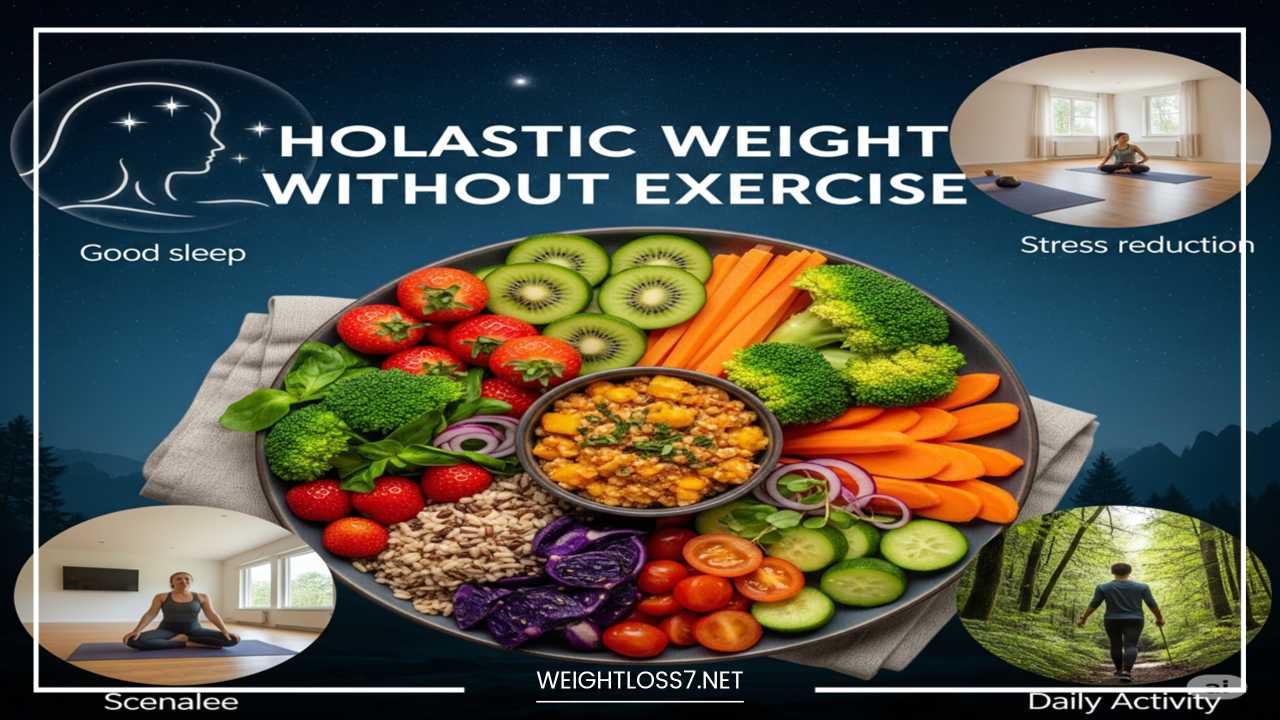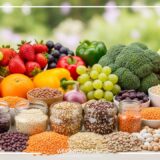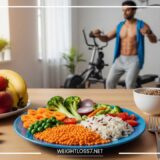How to Lose Weight Without Working Out
The Unconventional Path: How to Cultivate a Leaner You Without Stepping into a Gym
In a world saturated with intense workout regimes and the constant drumbeat of “no pain, no gain,” the idea of shedding excess weight without breaking a sweat can feel like a myth. Yet, for many, the traditional gym environment is inaccessible, unappealing, or simply not a viable option due to time constraints, physical limitations, or personal preference. This article delves into the less-trodden path of weight management, exploring how a fundamental recalibration of your daily habits, dietary choices, and understanding of your own metabolism can lead to sustainable weight loss, all without ever lacing up a pair of running shoes or lifting a dumbbell.
It’s crucial to state upfront: while this approach can yield results, it requires unwavering consistency and a deep commitment to conscious living. It’s not a magic bullet, nor is it necessarily a faster route than combining diet with regular physical activity. However, for those seeking an alternative, this comprehensive guide offers a roadmap to a leaner, healthier self through deliberate choices that transform your body from the inside out.
The Foundation: Understanding Energy Balance Beyond Exercise
At its core, weight loss boils down to a simple principle: consuming fewer calories than your body expends. This is known as creating a calorie deficit. While exercise dramatically increases calorie expenditure, it’s just one side of the energy balance equation. Your body burns calories 24/7 through a process called your Basal Metabolic Rate (BMR) – the energy required for fundamental bodily functions like breathing, circulation, and cell regeneration. Additionally, the calories burned through non-exercise activity thermogenesis (NEAT) play a significant, often underestimated, role.
The strategy here is to manipulate the “calories in” side of the equation with precision, and subtly increase the “calories out” through NEAT, rather than structured exercise.
Chapter 1: The Art of Mindful Eating – Revolutionizing Your Plate
This is arguably the most powerful lever for weight loss without dedicated workouts. What and how you eat dictates the vast majority of your daily calorie intake.
The Power of Plant-Centric Nutrition: A Deep Dive
Embracing a predominantly plant-based diet is not just a trend; it’s a nutritionally dense, fiber-rich, and often lower-calorie approach that naturally lends itself to weight management. Without mentioning any animal products, we focus on the abundance of the plant kingdom:
-
Whole Grains for Sustained Energy: Shift away from refined grains (white bread, pasta, sugary cereals) towards whole grains like oats, quinoa, brown rice, barley, and whole wheat. These are packed with fiber, which aids digestion, promotes satiety, and stabilizes blood sugar, preventing energy crashes and subsequent cravings. The fiber in whole grains also requires more energy for your body to digest, a small but consistent calorie burn.
-
Legumes: The Protein Powerhouses: Lentils, chickpeas, black beans, kidney beans, and other legumes are nutritional champions. They are incredibly rich in plant-based protein and dietary fiber, a combination that keeps you feeling full for longer, reducing the likelihood of overeating. Incorporate them into stews, salads, soups, or even as a base for plant-based patties.
-
Fruits and Vegetables: Nature’s Calorie Counters: These are your best friends. They are incredibly low in calories yet high in volume, fiber, vitamins, and minerals. Filling half your plate with non-starchy vegetables at every meal is a simple yet profoundly effective strategy. Think leafy greens, broccoli, cauliflower, bell peppers, zucchini, berries, and apples. The high water content in many fruits and vegetables also contributes to a feeling of fullness.
-
Nuts and Seeds: Portion Control is Key: While calorie-dense, nuts (almonds, walnuts, pecans) and seeds (chia, flax, sunflower, pumpkin) are packed with healthy fats, fiber, and protein. They are excellent for satiety and provide essential nutrients. The key is strict portion control – a small handful is usually sufficient. Their fiber and fat content slow digestion, keeping hunger at bay.
-
Healthy Fats from Plants: Avocado, olives, and plant-based oils (olive, avocado, flaxseed) provide essential fatty acids that are vital for hormone production and nutrient absorption. While calorie-dense, these fats contribute significantly to satiety and overall well-being. Use them sparingly but consistently.
The Art of Portion Awareness: Shrinking Your Plate, Not Your Satisfaction
Without the calorie burn of exercise, portion control becomes paramount.
- Smaller Plates, Bigger Impact: Simply using a smaller plate can trick your brain into feeling more satisfied with less food.
- Mindful Eating Practices: Slow down. Chew your food thoroughly. Pay attention to the flavors, textures, and aromas. Put your fork down between bites. This gives your brain time to register fullness signals, preventing overeating.
- No Distractions: Avoid eating in front of the TV, computer, or while scrolling on your phone. These distractions can lead to mindless consumption.
- Listen to Your Body’s Cues: Learn to differentiate between true hunger and emotional cravings. Stop eating when you are comfortably full, not stuffed.
Strategic Meal Timing and Frequency: Optimizing Your Metabolic Rhythm
While the traditional advice of “eating every few hours” is debated, some strategies can support weight loss without exercise:
- Intermittent Fasting (IF) Lite: This isn’t about extreme deprivation but rather creating a structured eating window. For instance, an 8-10 hour eating window (e.g., 10 AM to 6 PM) followed by a 14-16 hour fasting period allows your body to tap into stored fat for energy. During the fasting window, consume only water, herbal tea, or black coffee. Always consult with a healthcare professional before starting any significant dietary change.
- Front-Loading Calories: Consuming a larger, nutrient-dense breakfast and a moderate lunch, with a lighter dinner, can align better with your body’s natural metabolic rhythm and potentially lead to better glucose control and less evening snacking.
- Hydration, Hydration, Hydration: Often overlooked, adequate water intake is crucial. Sometimes, thirst is mistaken for hunger. Drinking a glass of water before meals can also help you feel fuller and consume less. Herbal teas can also contribute to hydration and satiety.
Chapter 2: Beyond the Plate – Lifestyle Adjustments for Effortless Calorie Burn
While direct exercise is out, subtle shifts in daily activity and overall lifestyle can significantly impact your energy expenditure. This is where NEAT comes into play.
Harnessing the Power of NEAT: Non-Exercise Activity Thermogenesis
NEAT refers to the energy expended for everything we do that is not sleeping, eating, or sports-like exercise. It includes1 walking to the pantry, fidgeting, standing, and even chewing. Increasing NEAT can burn hundreds of extra calories per day without feeling like a workout.
- Stand More, Sit Less: If you have a desk job, invest in a standing desk or find creative ways to stand more throughout the day. Take phone calls standing up.
- Embrace the Stairs: Skip the elevator and escalator whenever possible. Taking the stairs is a simple yet effective way to incorporate more movement.
- Walk Whenever Possible: Park further away, walk to nearby shops instead of driving, take a leisurely stroll around the block after dinner. These small walks add up.
- Fidget and Move: Consciously fidgeting, tapping your feet, or shifting positions burns more calories than sitting perfectly still.
- Active Chores: Engage enthusiastically in household chores like gardening, cleaning, or tidying up. These activities burn significant calories and contribute to a healthier home environment.
- Pace While Talking: If you’re on the phone, instead of sitting, try pacing around the room.
The Transformative Power of Quality Sleep
Sleep is often the missing link in many weight loss journeys. Poor sleep disrupts hormones that regulate appetite (ghrelin and leptin), leading to increased hunger and cravings for calorie-dense foods.
- Aim for 7-9 Hours: Prioritize consistent, uninterrupted sleep.
- Establish a Bedtime Routine: Create a calming ritual before bed – perhaps reading, gentle stretching, or a warm bath.
- Optimize Your Sleep Environment: Ensure your bedroom is dark, quiet, and cool. Avoid screens (phones, tablets, TV) at least an hour before bed.
Stress Management: Taming the Hormonal Beast
Chronic stress elevates cortisol levels, a hormone that can promote fat storage, particularly around the abdominal area, and increase cravings for unhealthy foods.
- Mindfulness and Meditation: Even 10-15 minutes of daily meditation or deep breathing exercises can significantly reduce stress.
- Connect with Nature: Spending time outdoors, even just sitting in a park, can have a calming effect.
- Hobbies and Relaxation: Engage in activities you enjoy that help you unwind, whether it’s reading, listening to music, or pursuing a creative outlet.
- Social Connection: Nurture healthy relationships. Positive social interactions can act as a buffer against stress.
Environmental Cues: Setting Yourself Up for Success
Your environment plays a huge role in your choices.
- Purge Unhealthy Foods: Remove tempting, calorie-dense, processed foods from your pantry and refrigerator. If it’s not there, you can’t eat it.
- Stock Healthy Options: Fill your kitchen with an abundance of fruits, vegetables, whole grains, and legumes. Make healthy choices the easy choices.
- Pre-Prepare Meals: On weekends, chop vegetables, cook grains, and prepare healthy snacks. This makes healthy eating effortless during busy weekdays.
- Eat at the Table: Make eating a dedicated activity, free from distractions.
Chapter 3: The Mental Game – Cultivating a Sustainable Mindset
Weight loss, particularly without the structured discipline of exercise, is a marathon, not a sprint. Your mindset is your greatest asset.
Patience and Persistence: The Unsung Heroes
- Realistic Expectations: Understand that weight loss without exercise may be slower. Celebrate small victories and focus on consistent progress rather than rapid drops.
- Embrace the Process: View this as a lifestyle transformation, not a temporary diet. Sustainable change takes time.
- Resilience in the Face of Setbacks: You will have days where you slip up. Don’t let one misstep derail your entire journey. Acknowledge it, learn from it, and get back on track immediately.
Tracking Progress: Beyond the Scale
The scale is just one metric. Focus on a holistic view of your progress:
- Non-Scale Victories (NSVs): How do your clothes fit? Do you have more energy? Is your sleep improving? Are your moods more stable? These are significant indicators of progress.
- Journaling: Track your food intake, sleep patterns, and mood. This can reveal patterns and help you identify areas for improvement.
- Measurements: Taking body measurements (waist, hips, thighs) every few weeks can show progress even when the scale doesn’t budge.
The Power of Positive Self-Talk and Self-Compassion
- Be Kind to Yourself: Avoid harsh self-criticism. Treat yourself with the same compassion you would offer a friend.
- Focus on the Positive: Acknowledge your efforts and celebrate your successes, no matter how small.
- Visualize Success: Regularly imagine yourself achieving your goals and living a healthier life.
Final Thoughts: A New Blueprint for Weight Loss
Losing weight without traditional workouts is a challenging but achievable endeavor that hinges on a profound commitment to dietary discipline and strategic lifestyle modifications. It’s a testament to the power of consistent, mindful choices in areas often overlooked in the pursuit of quick fixes. By meticulously managing your calorie intake through a plant-centric diet, embracing the subtle yet significant calorie burn of NEAT, prioritizing quality sleep, and mastering stress, you can create a sustainable path to a healthier weight.
This approach emphasizes that true transformation begins not in the gym, but in the kitchen, in your daily routines, and most importantly, in your mind. It empowers you to take control of your health through deliberate, consistent action, proving that a leaner, more vibrant you is possible, one conscious choice at a time. While exercise undoubtedly amplifies results and offers unique health benefits, this alternative path provides a powerful framework for those who seek to redefine their relationship with food, their bodies, and their overall well-being, without ever needing a barbell or a treadmill.


















